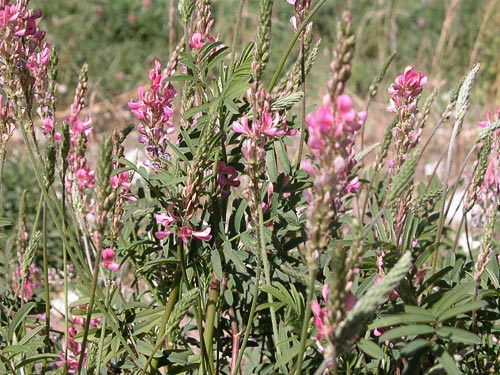Relatives
Onobrychis viciifolia Scop. - Sainfoin, St. Foin, holy grass.
Taxonomic position.
Family Leguminoseae Endl., genus Onobrychis Mill.Synonyms.
Hedysarum onobrychis L., Onobrychis sativa Lam.Biology and morphology.
Perennial herb. Pubescent plant with many erect or semi-erect, hollow stems, 15-90 cm tall, arising from basal buds on a branched root stock. The root system consists of a deep taproot with a few main branches and numerous, fine, lateral roots bearing most of the rhizobial nodules. Leaves are pinnate with 5-l4 pairs of obovate leaflets (15-80 mm long) and a terminal leaflet. Stipules are broad and finely pointed. There are numerous pinkish red flowers (11-13 long), borne in erect, conical racemes, on long axillary stalks. The flattened, indehiscent seed pods contain a single kidney-shaped seed, 4-6 mm in diameter. Seed color is dark olive to brown or black. Flowering occurs in May-June; seeds ripen in August-September. Plant is cross-pollinated mainly by honey bees. The chromosome number is 2n=2x=14 for diploids and 2n=4x=28 for tetraploids.Distribution.
Occurs throughout Ukraine, the Crimea, the European part of Russia, and the Caucasus.Ecology.
Plant grows in dry steppe meadows, along woods, among bushes, and on dry slopes. Plant is adapted to warm, temperate climates. Sainfoin has good drought resistance because of deep rooting and grows well in a variety of soils. It does especially well in highly fertile, well-drained, calcareous soils with high lime content. It does not do well in soils which are wet or have a high water table. Plant is intolerant of prolonged periods of flooding. It is intolerant of acidity and salinity.Utilization and economic value.
It is a very valuable forage crop in steppe areas. Because of its erect growth habit, this plant is better suited for infrequent cutting for conservation (hay or silage) than grazing. The herbage is highly nutritious. Onobrychis species have never been known to cause bloating, nor is it attacked by the alfalfa weevil. It is highly palatable to both sheep and cattle and is preferred over alfalfa. It may be grazed or used for hay, either alone or in mixtures with grasses. It grows well with Russian wild rye and crested wheatgrass. Longevity varies with ecotype or cultivar. It is an excellent source of nectar and pollen for honey bees.Reference citations:
Brezhnev D.D., Korovina O.N. 1980. Wild relatives of the cultivated plants of flora of the USSR. Leningrad: Kolos. 376 pp. (In Russian)Medvedev P.F., Smetannikova A.I. 1981. The forage crops of European part of the USSR. Leningrad: Kolos. 336 pp. (In Russian)
Phyodorov A.A., ed. 1987. Flora of the European part of the USSR. Vol. 6. 254 pp. (In Russian)
Schischkin V.K., Bobrov E.G., eds. 1945. Flora of the USSR. Vol. 11. Moscow-Leningrad: USSR. 430 pp. (In Russian)
Sinskaya E.N. 1948. Species dynamics. Moscow-Leningrad: Selhozgiz. 526 pp. (In Russian)


